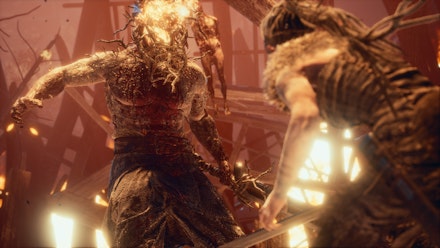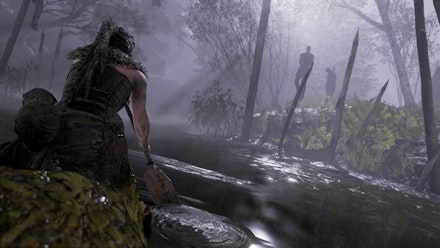Players begin Hellblade: Senua’s Sacrifice in a hollowed-out log, headed downstream toward the gates of hell. Save for your ultimate destination —and the various people skewered on pikes around you — it’s a fairly serene journey. Voices in protagonist Senua’s head urge her to turn around. “Go back. It’s not safe.” they say. It seems like spot-on advice, especially when given the assortment of human kebabs lining the beach.
As we soon discover though, not all the dialogue in Senua’s head can be trusted. She suffers from severe psychosis, so while some of the voices offer genuine help, others attempt to taunt and trick her. Along with frequent hallucinations, these voices help shape the story and characters. It’s a clever mechanic that not only steers the player’s journey, but also messes with their mind, providing a small sense of what the game's heroine is going through.

Hellblade deserves the praise for its innovative, mature, and sympathetic approach to portraying mental illness. But many of its more traditional game-focused features, such as combat and visual presentation, are equally worthy of attention. Developer Ninja Theory — no stranger to crafting stylish, satisfying encounters — has hit a sweet spot here, landing somewhere between the hack-and-slash of a fast-paced action game and the more strategic, methodical melees of a Dark Souls entry. The result is impactful, responsive, cinematic fights that call on you to carefully balance light and heavy attacks with parries and dodges.
Of course, it doesn't hurt that every blade strike’s brought to life by the game’s impeccable visuals. Whether opening a foe from brainstem to belly button or simply traversing Senua’s deeply unsettling surroundings, Hellblade consistently strives for photo-realism. This is especially apparent in its use of immersion-ratcheting effects. Early in the adventure, for example, Senua finds herself surrounded by a fiery blaze that threatens to consume her. More than your typical flashy fire effects, however, the set-piece is realised with realistic variations, from rapidly spreading flames and thick black smoke to floating embers and areas of crackling heat so obviously intense you can all but feel it warm your skin.

If Hellblade ever falters, it's in its slightly repetitive, occasionally tedious puzzle design. Players are frequently tasked with finding and matching shapes and patterns in the environment so they may progress. These feel fairly clever the first few times you sort them out, but they’re overused and, worse, become frustrating when a specific objective isn't entirely clear.
Still, this is a small gripe in one of the best story-driven action-adventure games so far this year. If you're craving a rich, albeit dark narrative experience, complemented by crunchy, rewarding combat, it's worth losing your mind in Hellblade’s eight or so hour run through the underworld.
